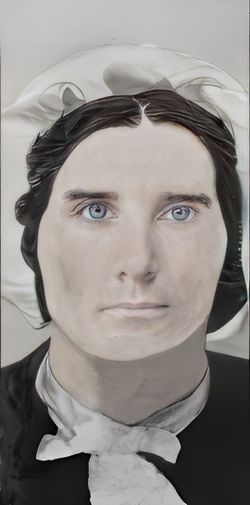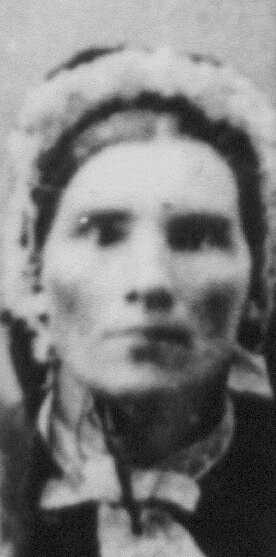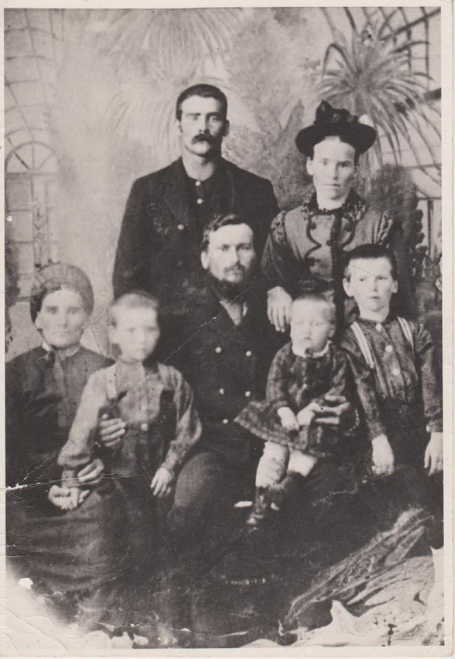My Gr Gr Aunt Elizabeth was the first child of this Storie line to be born in North America.
Tuesday evening, November 12, 1912, 7:00 p.m. and the sternwheeler Mayflower pulls away from the Barry's Bay dock. It was a very cold night with high winds. The trip they were commencing should have taken three hours at the normal operating speed of 5 to 7 miles per hour. Snow began falling about 9 p.m. With no warning, the Mayflower sank at a point approximately six hundred feet off the north shore of Kamaniskeg Lake near what are today known as Parcher and Mayflower Islands. The fate of the Mayflower and her passengers may have been quite different if only the Captain had received some indication of trouble. Many believe the ship would have made it to shore and everyone would have survived. At the request of local Councilor William Boehme, Captain Hudson had agreed to one last run of the season to Barry's Bay to retrieve a casket containing the body of one John (Herman) Brown that was coming into Barry's Bay on the Grand Trunk Railway. John had died November 7, 1912, in Saskatchewan, as a result of a 'mysterious' gun accident and his body was being returned home for burial in nearby Fort Stewart before winter set in. Accompanying the Captain were a number of locals who had been milling about at Combermere's Hudson House hotel that afternoon. They included pilot Aaron Parcher, Patrick O'Brien, owner of the O'Brien House in Combermere, G. P. Bothwell, a commercial traveler from Ottawa, William Boehme, a Combermere tailor, Mrs. McWhirter (Elizabeth Stewart Storie McWhirter) from Fort Stewart, William Murphy of Rockingham, Tom Delaney, of Barry's Bay, the Mayflower's fireman, and Robert Pachel of Yorkton, Saskatchewan who was ccompanying John Brown's body. Three commercial travelers, M. J. Harper, Gordon Peverly and J. S. Imlach, all of Ottawa, also were on board.
Everyone with the exception of Harper, Peverly and Imlach, perished when Kamaniskeg Lake swallowed up the Mayflower. They were able to cling to the casket; the only thing left floating, and made their way to one of the two islands in Kamaniskeg Lake. Stormy weather hampered the search parties that made several passes of the island before finding the men. Eventually, afterward of finding Aaron Parcher's body reached Combermere, the steamer Ruby set out and brought the survivors back to the Hudson House.
Captain John Hudson, also the Reeve of Radcliffe Township at the time, was only 47 years old and left behind a wife, Margaret Mahon, aged 36 years, and eight year old son Edwin. Aaron Parcher, 26, left behind a wife, Maude McLean, and two small children. In a brave attempt to save his passengers, it is said, Captain Hudson made his way below deck to shut off the engines in the hopes of preventing an explosion. His body was later found beside the ship in about 40 feet of water. Napoleon Tessier built the Mayflower in Combermere in 1903 for two brothers, John Charles Hudson and Henry Edwin Hudson. Built from oak, hemlock and local pine, she was launched and commissioned in
1904. Her official registered number was 116,861, with a gross tonnage of 58.86 and net tonnage of 38.02. Length was 77', breadth 18', depth of 4' and height about 20'. It was almost a flat bottom wooden boat designed with shallow draught for navigating the shallow waters over some shoals and sandbars on the Madawaska and York Rivers. Some described her looking like a scow.
Two cross compound steam engines powered the vessel with the steam being supplied by a Fitzgibbon boiler mounted amidships, three and one half feet below the deck. J & R Weir of Montréal designed the vessel and supplied the major engine/steam components. The single rear paddle wheel was set into a cut in the stern and had twelve paddles. A modification to the paddle wheel was made some years after launch because the boat tended to porpoise when underway and caused considerable hardship in handling and steering. Two rudders, mounted off to the sides and aft of the paddle wheel, helped the narrow boat navigate the sharp corners in the Madawaska River, particularly around the present day Pine Cliff Resort. She had a previous mishap in 1911 when she ran into a log deadhead on the Madawaska River and partially sank. By 1912, some claimed the boat was not seaworthy and was lacking certification by the authorities yet others claim the steamer had been officially inspected the summer before it sank.
A number of reasons have been put forward as to why the Mayflower sank including: poor maintenance, too shallow a draught and therefore subject to rough waves coming over the bow, sides and rear into the interior of the boat, the snowy, windy, cold weather that night, pilot Aaron Parcher not being properly certified to operate the boat, the modification to the paddles of the paddle wheel, oakum (caulking) disintegration between the ship boards, and no cargo on board to provide proper boat balance. There were also rumors that the Captain and perhaps some of the crew had been drinking at the Balmoral Hotel in Barry's Bay earlier that evening; however, this was never substantiated at the inquest. Regardless of the reason(s), today she lies on the sandy bottom of Kamaniskeg Lake, a broken and rotting corpse, cold and silent. In her prime, the May flower carried all types of goods between the docks in Palmer Rapids, Craigmont, Combermere and Barry's Bay. Her freight books, still in the hands of Captain Hudson's cousins, record such shipments as spades and plows, buggy parts, tubs of butter, boxes of cheese, bags of bran, barley and flour, roofing, cement and bars of steel as just some of the items from the 1908 shipping season. The Mayflower's grave is the most popular dive site in the area. If you should happen to venture down to the remains of the Mayflower, you will see that the boat has a very slight list to her portside with the hull being completely intact.
The boiler is also intact, indicating that it did not blow up during the events of NoNovember 12, 1912. The two 13.5 hp engines, brake, paddle wheel and paddles are still evident; however some of the paddles have rotted away. Off to the side you will see the two large posts with attached cable. The cabin and wheelhouse are in many pieces off both sides of the boat on the bottom. You can also see, on the starboard side of the deck, a small linoleum floor covering where the bathroom would have been, with a hole in the floor where the round naval style head or toilet bowl would have been placed. On both sides of the hull pipe insulation, numerous boards, pipes and metal parts from the boiler and drive mechanisms are evident. The Combermere Centennial Committee chose, as a Centennial project, the creation of a park to honor the memory of those who perished. Mayflower Park, in downtown Combermere at the boat-launching ramp, was opened in the summer of 1967. In attendance was Edwin Hudson, son of the late Captain John Hudson. Was it sabotage, natural calamity or just the nature of an aging vessel that caused what was recognized at the time as the worst inland shipping disaster in Canada? No one is truly sure. But we do know that the corpse survived and in so doing saved three lives. To learn more about the mysterious Mayflower visit the Mission House Museum and Gallery in Combermere.
By Kent Waddington The Combermere Free Press
My Gr Gr Aunt Elizabeth was the first child of this Storie line to be born in North America.
Tuesday evening, November 12, 1912, 7:00 p.m. and the sternwheeler Mayflower pulls away from the Barry's Bay dock. It was a very cold night with high winds. The trip they were commencing should have taken three hours at the normal operating speed of 5 to 7 miles per hour. Snow began falling about 9 p.m. With no warning, the Mayflower sank at a point approximately six hundred feet off the north shore of Kamaniskeg Lake near what are today known as Parcher and Mayflower Islands. The fate of the Mayflower and her passengers may have been quite different if only the Captain had received some indication of trouble. Many believe the ship would have made it to shore and everyone would have survived. At the request of local Councilor William Boehme, Captain Hudson had agreed to one last run of the season to Barry's Bay to retrieve a casket containing the body of one John (Herman) Brown that was coming into Barry's Bay on the Grand Trunk Railway. John had died November 7, 1912, in Saskatchewan, as a result of a 'mysterious' gun accident and his body was being returned home for burial in nearby Fort Stewart before winter set in. Accompanying the Captain were a number of locals who had been milling about at Combermere's Hudson House hotel that afternoon. They included pilot Aaron Parcher, Patrick O'Brien, owner of the O'Brien House in Combermere, G. P. Bothwell, a commercial traveler from Ottawa, William Boehme, a Combermere tailor, Mrs. McWhirter (Elizabeth Stewart Storie McWhirter) from Fort Stewart, William Murphy of Rockingham, Tom Delaney, of Barry's Bay, the Mayflower's fireman, and Robert Pachel of Yorkton, Saskatchewan who was ccompanying John Brown's body. Three commercial travelers, M. J. Harper, Gordon Peverly and J. S. Imlach, all of Ottawa, also were on board.
Everyone with the exception of Harper, Peverly and Imlach, perished when Kamaniskeg Lake swallowed up the Mayflower. They were able to cling to the casket; the only thing left floating, and made their way to one of the two islands in Kamaniskeg Lake. Stormy weather hampered the search parties that made several passes of the island before finding the men. Eventually, afterward of finding Aaron Parcher's body reached Combermere, the steamer Ruby set out and brought the survivors back to the Hudson House.
Captain John Hudson, also the Reeve of Radcliffe Township at the time, was only 47 years old and left behind a wife, Margaret Mahon, aged 36 years, and eight year old son Edwin. Aaron Parcher, 26, left behind a wife, Maude McLean, and two small children. In a brave attempt to save his passengers, it is said, Captain Hudson made his way below deck to shut off the engines in the hopes of preventing an explosion. His body was later found beside the ship in about 40 feet of water. Napoleon Tessier built the Mayflower in Combermere in 1903 for two brothers, John Charles Hudson and Henry Edwin Hudson. Built from oak, hemlock and local pine, she was launched and commissioned in
1904. Her official registered number was 116,861, with a gross tonnage of 58.86 and net tonnage of 38.02. Length was 77', breadth 18', depth of 4' and height about 20'. It was almost a flat bottom wooden boat designed with shallow draught for navigating the shallow waters over some shoals and sandbars on the Madawaska and York Rivers. Some described her looking like a scow.
Two cross compound steam engines powered the vessel with the steam being supplied by a Fitzgibbon boiler mounted amidships, three and one half feet below the deck. J & R Weir of Montréal designed the vessel and supplied the major engine/steam components. The single rear paddle wheel was set into a cut in the stern and had twelve paddles. A modification to the paddle wheel was made some years after launch because the boat tended to porpoise when underway and caused considerable hardship in handling and steering. Two rudders, mounted off to the sides and aft of the paddle wheel, helped the narrow boat navigate the sharp corners in the Madawaska River, particularly around the present day Pine Cliff Resort. She had a previous mishap in 1911 when she ran into a log deadhead on the Madawaska River and partially sank. By 1912, some claimed the boat was not seaworthy and was lacking certification by the authorities yet others claim the steamer had been officially inspected the summer before it sank.
A number of reasons have been put forward as to why the Mayflower sank including: poor maintenance, too shallow a draught and therefore subject to rough waves coming over the bow, sides and rear into the interior of the boat, the snowy, windy, cold weather that night, pilot Aaron Parcher not being properly certified to operate the boat, the modification to the paddles of the paddle wheel, oakum (caulking) disintegration between the ship boards, and no cargo on board to provide proper boat balance. There were also rumors that the Captain and perhaps some of the crew had been drinking at the Balmoral Hotel in Barry's Bay earlier that evening; however, this was never substantiated at the inquest. Regardless of the reason(s), today she lies on the sandy bottom of Kamaniskeg Lake, a broken and rotting corpse, cold and silent. In her prime, the May flower carried all types of goods between the docks in Palmer Rapids, Craigmont, Combermere and Barry's Bay. Her freight books, still in the hands of Captain Hudson's cousins, record such shipments as spades and plows, buggy parts, tubs of butter, boxes of cheese, bags of bran, barley and flour, roofing, cement and bars of steel as just some of the items from the 1908 shipping season. The Mayflower's grave is the most popular dive site in the area. If you should happen to venture down to the remains of the Mayflower, you will see that the boat has a very slight list to her portside with the hull being completely intact.
The boiler is also intact, indicating that it did not blow up during the events of NoNovember 12, 1912. The two 13.5 hp engines, brake, paddle wheel and paddles are still evident; however some of the paddles have rotted away. Off to the side you will see the two large posts with attached cable. The cabin and wheelhouse are in many pieces off both sides of the boat on the bottom. You can also see, on the starboard side of the deck, a small linoleum floor covering where the bathroom would have been, with a hole in the floor where the round naval style head or toilet bowl would have been placed. On both sides of the hull pipe insulation, numerous boards, pipes and metal parts from the boiler and drive mechanisms are evident. The Combermere Centennial Committee chose, as a Centennial project, the creation of a park to honor the memory of those who perished. Mayflower Park, in downtown Combermere at the boat-launching ramp, was opened in the summer of 1967. In attendance was Edwin Hudson, son of the late Captain John Hudson. Was it sabotage, natural calamity or just the nature of an aging vessel that caused what was recognized at the time as the worst inland shipping disaster in Canada? No one is truly sure. But we do know that the corpse survived and in so doing saved three lives. To learn more about the mysterious Mayflower visit the Mission House Museum and Gallery in Combermere.
By Kent Waddington The Combermere Free Press
Inscription
The victims of this disaster were:
J.C. Hudson, Combermere, Ont., owner and engineer
A. Parcher, Combermere, Ont., pilot
J. Delaney, Barry's Bay, fireman
George Bothwell, Ottawa, passenger
R. Pachal, Yorkton, Sask, passenger
P. O'Brien, Combermere, passenger
Wm. Boehme, Combermere, passenger
Wm. Murphy, Rockingham, passenger
Mrs. Elizabeth McWhirter, Fort Stewart, passenger
Gravesite Details
Cause of death; drowning
Family Members
Sponsored by Ancestry
Advertisement
Records on Ancestry
Advertisement


















